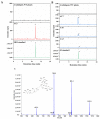Plant Metabolic Engineering by Multigene Stacking: Synthesis of Diverse Mogrosides
- PMID: 36142335
- PMCID: PMC9499096
- DOI: 10.3390/ijms231810422
Plant Metabolic Engineering by Multigene Stacking: Synthesis of Diverse Mogrosides
Abstract
Mogrosides are a group of health-promoting natural products that extracted from Siraitia grosvenorii fruit (Luo-han-guo or monk fruit), which exhibited a promising practical application in natural sweeteners and pharmaceutical development. However, the production of mogrosides is inadequate to meet the need worldwide, and uneconomical synthetic chemistry methods are not generally recommended for structural complexity. To address this issue, an in-fusion based gene stacking strategy (IGS) for multigene stacking has been developed to assemble 6 mogrosides synthase genes in pCAMBIA1300. Metabolic engineering of Nicotiana benthamiana and Arabidopsis thaliana to produce mogrosides from 2,3-oxidosqualene was carried out. Moreover, a validated HPLC-MS/MS method was used for the quantitative analysis of mogrosides in transgenic plants. Herein, engineered Arabidopsis thaliana produced siamenoside I ranging from 29.65 to 1036.96 ng/g FW, and the content of mogroside III at 202.75 ng/g FW, respectively. The production of mogroside III was from 148.30 to 252.73 ng/g FW, and mogroside II-E with concentration between 339.27 and 5663.55 ng/g FW in the engineered tobacco, respectively. This study provides information potentially applicable to develop a powerful and green toolkit for the production of mogrosides.
Keywords: mogrosides; multigene assembly; natural sweetener; plant chassis; synthetic biology.
Conflict of interest statement
The authors declare no conflict of interest.
Figures







Similar articles
-
Development of New Multi-Glycosylation Routes to Facilitate the Biosynthesis of Sweetener Mogrosides from Bitter Immature Siraitia Grosvenorii Using Engineered Escherichia coli.J Agric Food Chem. 2024 Aug 14;72(32):18078-18088. doi: 10.1021/acs.jafc.4c03154. Epub 2024 Jul 30. J Agric Food Chem. 2024. PMID: 39078882
-
Prediction of the sweetening effect of Siraitia grosvenorii (luo han guo) fruits by two-dimensional quantitative NMR.Food Chem. 2021 Jan 15;335:127622. doi: 10.1016/j.foodchem.2020.127622. Epub 2020 Jul 25. Food Chem. 2021. PMID: 32739811
-
Dekkera bruxellensis, a beer yeast that specifically bioconverts mogroside extracts into the intense natural sweetener siamenoside I.Food Chem. 2019 Mar 15;276:43-49. doi: 10.1016/j.foodchem.2018.09.163. Epub 2018 Sep 29. Food Chem. 2019. PMID: 30409616
-
[Synthetic biology for the synthesis of mogroside V - a review].Sheng Wu Gong Cheng Xue Bao. 2020 Oct 25;36(10):2017-2028. doi: 10.13345/j.cjb.200072. Sheng Wu Gong Cheng Xue Bao. 2020. PMID: 33169567 Review. Chinese.
-
Recent advancements in mogrosides: A review on biological activities, synthetic biology, and applications in the food industry.Food Chem. 2024 Aug 15;449:139277. doi: 10.1016/j.foodchem.2024.139277. Epub 2024 Apr 7. Food Chem. 2024. PMID: 38608607 Review.
Cited by
-
Gene Stacking and Stoichiometric Expression of ER-Targeted Constructs Using "2A" Self-Cleaving Peptides.Methods Mol Biol. 2024;2772:337-351. doi: 10.1007/978-1-0716-3710-4_26. Methods Mol Biol. 2024. PMID: 38411827
-
Bibliometric analysis on the literature of monk fruit extract and mogrosides as sweeteners.Front Nutr. 2023 Aug 29;10:1253255. doi: 10.3389/fnut.2023.1253255. eCollection 2023. Front Nutr. 2023. PMID: 37706210 Free PMC article.
-
Pharmacological Activities of Mogrol: Potential Phytochemical against Different Diseases.Life (Basel). 2023 Feb 16;13(2):555. doi: 10.3390/life13020555. Life (Basel). 2023. PMID: 36836915 Free PMC article. Review.
References
-
- Food and Drug Administration, U.S.A GRAS Notice 000693: Generally Recognized as Safe (GRAS) Status of D-Allulose (D-Psicose) [(accessed on 2 February 2017)]; Available online: https://www.fda.gov/Food/IngredientsPackagingLabeling/GRAS/NoticeInventory.
-
- Food and Drug Administration, U.S.A GRAS Notice 000253: Rebaudioside A for Use as a General Purpose Sweetener. [(accessed on 14 March 2008)]; Available online: https://www.fda.gov/Food/IngredientsPackagingLabeling/GRAS/NoticeInventory.
-
- Food and Drug Administration, U.S.A GRAS Notice 000301: Luo Han Fruit. [(accessed on 15 January 2010)]; Available online: https://www.fda.gov/Food/IngredientsPackagingLabeling/GRAS/NoticeInventory.
-
- Sun-Waterhouse D., Wadhwa S.S. Industry-relevant approaches for minimising the bitterness of bioactive compounds in functional foods: A review. Food Bioprocess Technol. 2013;6:607–627. doi: 10.1007/s11947-012-0829-2. - DOI
MeSH terms
Substances
Grants and funding
LinkOut - more resources
Full Text Sources
Research Materials

